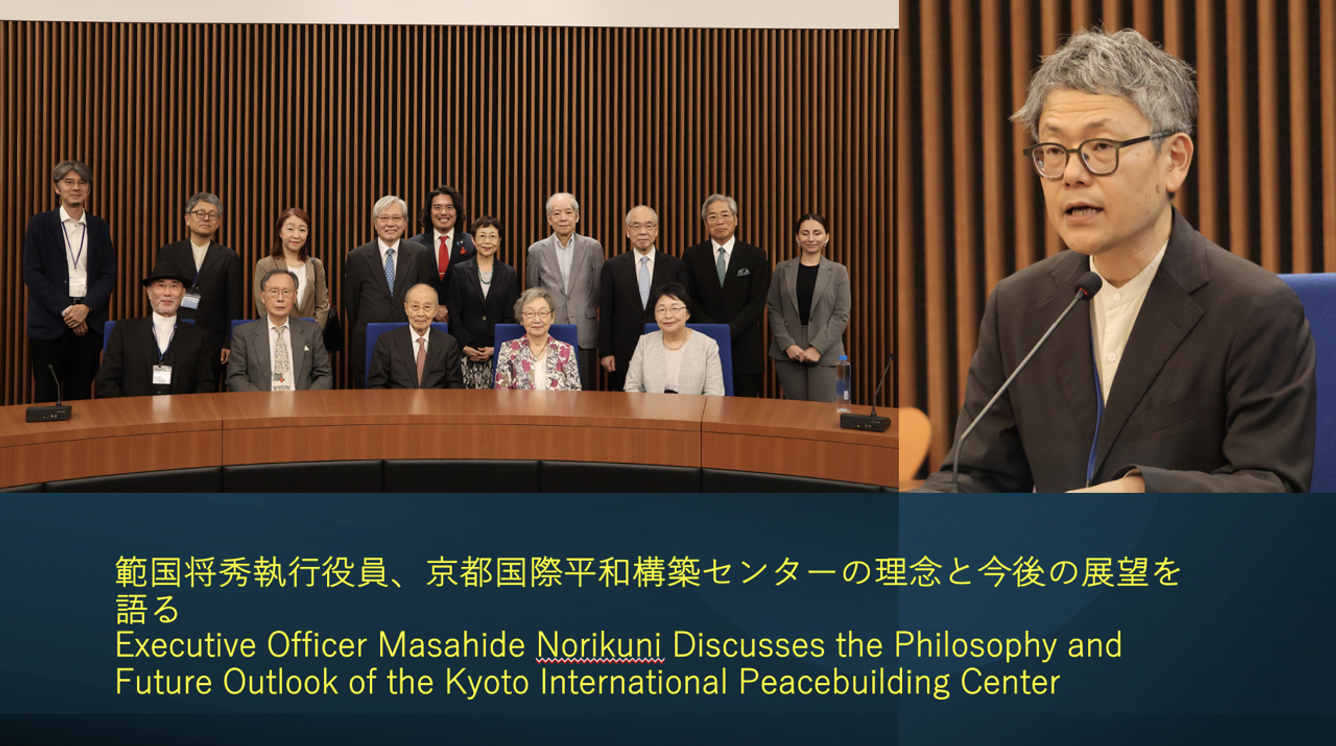
At the 2025 Council Meeting of the Kyoto International Peacebuilding Center (KPC), Masahide Norikuni, Executive Officer of KPC, delivered remarks reflecting on the founding philosophy, progress, and future outlook of the Center. His speech addressed the renewal of collaboration with the Academic Council on the United Nations System (ACUNS), the guiding vision of “Art as a Nation”, and the increasingly international character of Kyoto University of the Arts.
Norikuni began by announcing that on May 9, KPC renewed its partnership agreement with ACUNS through 2028, following discussions in Vienna between Chairman Tokuyama and ACUNS President Professor Franz Bauman. He also reported that Kyoto University of the Arts President Taku Sato attended the 50th Anniversary Ceremony of the United Nations University on September 18, underscoring the university’s intention to further strengthen cooperation with both ACUNS and UNU.
He then reflected on the founding ideals of KPC, established in March 2021 and soon to celebrate its fifth anniversary. The Center, he explained, was founded under the university’s principle of “Art as a Nation – Toward a University that Seeks Peace.” Its mission is to contribute to international peacebuilding through the power of art and culture, addressing key global challenges such as security, development, poverty, and environmental conservation through knowledge exchange and creative collaboration.
Looking ahead, Norikuni emphasized that Kyoto University of the Arts will mark its 50th anniversary in 2027, and expressed hope that Council members will actively participate in the commemorative programs. “Through these activities, we aim to make KPC’s vision more widely known and to share our founding philosophy with the broader public,” he said.
In the latter part of his remarks, Norikuni spoke about the international nature of the university’s graduate school, noting that approximately 80% of the students are from China, with a highly competitive acceptance rate of over 10 to 1. “Even top Japanese students sometimes cannot pass,” he noted, “but this is not a negative thing. On the contrary, it is a source of pride if our Chinese graduates go on to become world-renowned artists and designers.”
He also analyzed the reasons behind the increase in Chinese students at Japanese art universities: “One reason is the pursuit of design careers—many see real value in studying at Japanese graduate schools. Another is the global popularity of Japanese content such as manga and animation, which enhances the appeal of Japanese art universities as study destinations.” Norikuni concluded, “This trend represents one of the defining characteristics of contemporary art education and its international attractiveness.”
For the full detail of the conference, please click here.
【Full Transcript (English Translation)】
Speech 1
This year’s key topic is the renewal of our cooperation agreement with ACUNS through 2028, which was signed on May 9 following discussions in Vienna between Chairman Tokuyama and Professor Franz Bauman. In addition, on September 18, Kyoto University of the Arts President Taku Sato attended the 50th Anniversary Ceremony of the United Nations University. We intend to further strengthen our collaboration with both ACUNS and UNU.
The Kyoto International Peacebuilding Center was established in March 2021 and will mark its fifth anniversary next year. This year therefore serves as a milestone for us. With the addition of former Foreign Minister Yoriko Kawaguchi as a new Council member, I would like to take this opportunity to reflect on why our university founded the Center, and how its philosophy aligns with the founding vision of our institution.
The document “Art as a Nation – Toward a University that Seeks Peace” can be found here:
https://www.kyoto-art.ac.jp/info/philosophy/files/artsnation.pdf
Under the principle of “Art as a Nation,” the Kyoto International Peacebuilding Center seeks to contribute to global peace by promoting knowledge sharing and collaboration in areas such as culture, security, development, poverty reduction, and environmental protection—utilizing art and cultural expression as tools for peacebuilding.
Kyoto University of the Arts will celebrate its 50th anniversary in 2027, making next year and 2027 “anniversary years.” As Professor Nakayama will also discuss later, we sincerely hope for everyone’s participation and ideas as we prepare for this important occasion.
Speech 2
Since the topic has been raised, let me share a few points about our university. At present, roughly 80% of the students in our graduate school are from China, and the competition ratio is extremely high—more than ten applicants for every seat. In some cases, even excellent Japanese students are unable to gain admission. Currently, the level of Chinese students is remarkably high.
However, we view this trend positively. In fields such as fine arts, design, and architecture, it is a great source of pride for us if Chinese students who study here go on to become world-renowned artists and designers.
We see this as a positive evolution of modern education, and we feel no stress or burden in accommodating it.
Speech 3
As has been widely reported, Japan’s art graduate schools are attracting a growing number of students from China. There are several reasons behind this trend.
One is career development—many students see studying in Japan as an important step toward becoming professional designers. Another factor is the global popularity of Japanese content, such as manga and animation, which enhances the appeal of Japanese art universities and drives demand for study abroad in this field.
In this sense, the increase in Chinese students represents a major current within the contemporary landscape of art education in Japan.
(Reported by Koki IMON)
